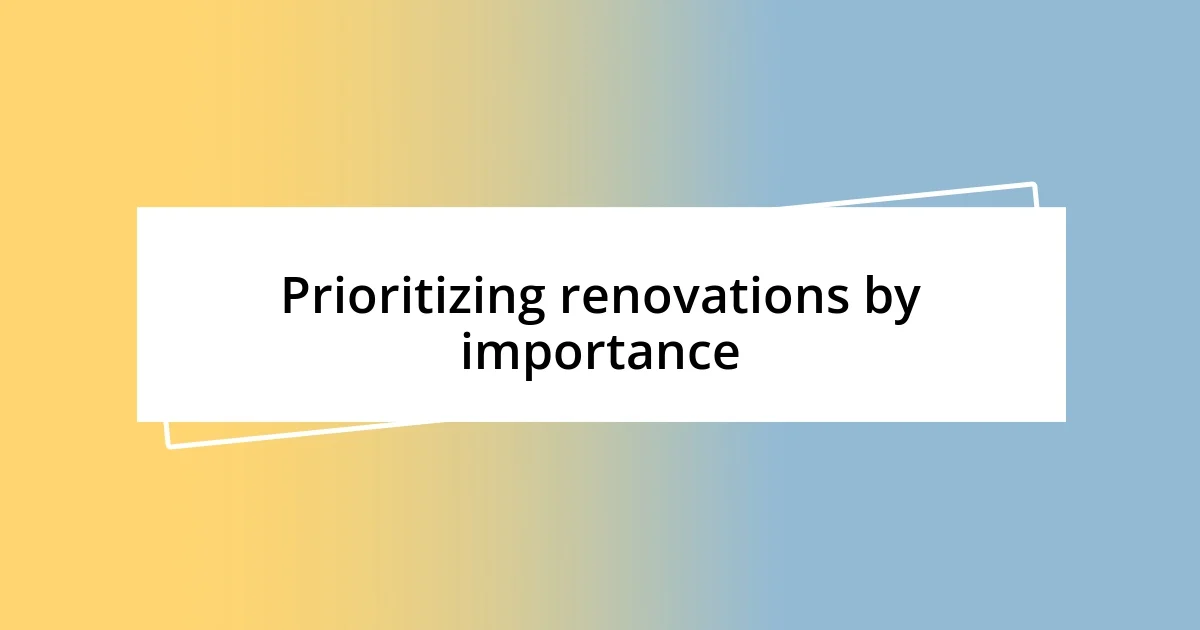Key takeaways:
- Labor constitutes 20-35% of renovation costs; a contingency fund of 10-20% is essential for unexpected expenses.
- Prioritize necessary renovations over cosmetic updates and consider return on investment; balance luxury with practicality.
- Create a detailed expense tracking system and remain flexible with your budget to accommodate unforeseen changes.

Understanding home renovation costs
Understanding home renovation costs can feel overwhelming at first. I remember when I was about to start my kitchen remodel; the estimated costs seemed to balloon with each additional feature I wanted. Have you ever felt that sense of dread when a simple project suddenly snowballs into something more expensive?
When I dove into the details, I realized that labor often accounts for about 20-35% of the total renovation cost. This was a game-changer for me. I thought I could save by going the DIY route, but the time and stress it added made me rethink. It’s essential to balance your enthusiasm for DIY with the practicalities of your own skill set and time availability.
Unexpected costs can surface at any stage, and I learned this the hard way when I had to replace hidden plumbing issues. This experience taught me the importance of having a contingency budget. A good rule of thumb is to set aside an additional 10-20% of your overall budget for those surprises that life likes to throw your way. After all, it’s not just about making your space beautiful; it’s about ensuring you can enjoy that beauty without financial regret.

Setting a realistic budget
Setting a realistic budget requires a clear understanding of both your financial limits and the scope of your renovation. In my experience, it’s easy to get excited about fancy upgrades, but I’ve learned to step back and assess what I truly need versus what I want. One time, I found myself falling in love with high-end finishes, only to realize later that they would push my budget far beyond what I could comfortably manage. To keep my spending in check, I started breaking down my renovation into essential categories.
Here are some key categories to consider when setting your budget:
- Materials: Research costs for your desired materials vs. alternatives.
- Labor: Factor in whether you’ll hire professionals or handle projects yourself.
- Permits: Don’t forget to include any local regulations that may require fees.
- Contingency Fund: Allocate 10-20% for unexpected costs.
- Design Fees: If you’re working with a designer, their fees can add up fast.
Making these distinctions helped me prioritize wisely, ensuring I can achieve the vision without the stress of overspending. Balancing aspirations with financial realities can lead to a smoother renovation experience.

Prioritizing renovations by importance
When it comes to prioritizing renovations, I’ve found it’s crucial to distinguish between necessary improvements and those that are simply nice to have. For instance, when I tackled my living room overhaul, I realized that addressing structural issues, like fixing a leaky roof, had to come first. I remember sitting in that room while it rained, wondering why I’d delayed on repairs—nothing felt worse than realizing the beautiful decor would be meaningless if the space wasn’t functional. So, always start with what affects the integrity of your home.
Another important aspect is considering the return on investment (ROI). I’ve personally learned this lesson when renovating my bathroom; I thought high-end fixtures would be the key, but I soon discovered that practical updates, like modern plumbing, held far greater value. With so many projects and budget constraints, I focused on items that not only elevated the space but also made sense financially. This focus transformed my renovation approach and allowed me to invest wisely.
Lastly, I cannot stress how beneficial it is to look at the overall vision of your home. Think of renovations as a puzzle—some pieces, like energy-efficient windows, not only enhance your living space but save money long-term. While I was excited to add a lush garden, I quickly recognized that improving insulation would provide instant savings on my energy bills, thereby enhancing my overall comfort. Balancing luxury with practicality has made my renovation journey enjoyable and sustainable.
| Priority Level | Examples |
|---|---|
| High | Structural Repairs, Plumbing, Electrical Updates |
| Medium | Kitchen Updates, Bathroom Remodels |
| Low | Cosmetic Changes, Landscaping |

Finding cost-effective materials
Finding cost-effective materials can be a game-changer for any renovation project. I remember when I was looking for flooring options; I fell down the rabbit hole of luxurious hardwoods. However, upon further research, I found laminate that not only mimicked the appearance of wood beautifully but was significantly cheaper and easier to maintain. Have you ever considered how much you can save just by being open to alternatives?
One of my favorite strategies is to explore local salvage yards and thrift stores. On a whim, I visited one during a Saturday stroll and stumbled upon beautiful reclaimed wood. Not only did it add character to my space, but it also came with a price tag that left my budget intact. It felt like I was unearthing hidden gems. Can you imagine the satisfaction of finding something that perfectly matches your vision for a fraction of the cost?
Don’t forget to connect with your community. Online groups and forums often have people who are looking to offload leftover materials from their projects. I once acquired a whole slew of tiles that someone no longer needed, transforming what could have been an ordinary backsplash into something unique and personal. It’s amazing how collaboration can lead to inspiration while also helping your wallet!

Seeking professional advice wisely
Getting professional advice is essential, but choosing the right time and method can make all the difference. I recall a renovation where I rushed to hire an architect without thoroughly understanding my vision, leading to expensive miscommunications. Have you ever felt lost in a project and thought an expert would clarify everything? The truth is, taking the time to define your goals first can help you select a professional who aligns perfectly with your vision.
I’ve also learned the value of seeking recommendations. For my kitchen remodel, I asked friends and family for referrals, which led me to a designer who not only fit my budget but also shared my aesthetic preferences. The bond we developed allowed for candid conversations, which meant I wasn’t just following a cookie-cutter plan but collaborating on something truly unique. It’s incredible how personal connections can lead to great results, don’t you think?
Finally, consider the timing when seeking advice. I was eager to dive into my renovation, but waiting until I’d gathered the necessary information about permits and local regulations saved me from potential setbacks. I found that by having all my ducks in a row, I could engage experts more effectively—it lessened my anxiety and made every consultation feel productive. It’s all about maximizing your interactions with professionals to avoid unnecessary hiccups along the way.

Tracking expenses during renovation
Keeping track of expenses during a renovation might seem daunting, but it’s essential for staying within budget. I remember tackling my bathroom remodel; I created a simple spreadsheet where I logged every purchase, from tiles to faucets. Seeing it all in one place helped me avoid the sinking feeling of overspending that I’d experienced in previous projects. Have you ever felt that rush of panic after an impulsive buy?
A great tool that really helped me was a budgeting app specifically designed for home renovations. I could categorize expenses, set reminders for payments, and even track my progress against my original budget. One night, as I sat on my couch reviewing my entries, I realized I had saved a significant amount by sticking to my planned purchases. It felt empowering to see the numbers balance out—it reminded me that financial discipline was definitely paying off.
Don’t forget to factor in the unexpected costs that may arise during your renovation. I learned this firsthand when I opened up the walls in my living room and found outdated wiring that needed immediate attention. While it was a blow to my budget, keeping a cushion for these surprises in my tracking sheet allowed me to address them without panic. Have you encountered surprises in your projects? It’s this kind of preparation that can turn potential disasters into manageable bumps in the road.

Adjusting your budget as needed
Adjusting your budget as needed is a crucial skill that can make or break your renovation project. I remember when I had to rethink my budget midway through a big kitchen overhaul. An unexpected plumbing issue popped up, and instead of panicking, I evaluated the overall picture. By reallocating funds from less critical areas, I was able to tackle that surprise without derailing my project. Have you ever found yourself in a tight spot where a change felt overwhelming? It’s amazing how a little flexibility can ease your mind.
Moreover, I often reflect on how renovations can reveal the importance of prioritizing certain aspects over others. During my living room remodel, I decided to splurge on high-quality flooring, realizing that it would make a lasting impact on the space. Adjusting my budget meant trimming back on less important details, like decorative accents, which ultimately allowed me to invest more where it truly mattered. It’s all about strategic thinking, isn’t it? Finding the balance between wants and needs can feel daunting, but with a clear vision, it becomes much easier.
Sometimes, an emotional response can cloud your judgment when it comes to budgets. I felt an overwhelming urge to include that beautiful custom cabinet, even though it was a hefty expenditure. I paused and asked myself if it would serve my long-term vision or if it was just a fleeting desire. By having open conversations with my partner, we reached a consensus that aligned our priorities. How often do you wrestle with emotional spending during a renovation? Being honest about your choices is essential for maintaining a budget that respects both your dreams and your financial reality.












